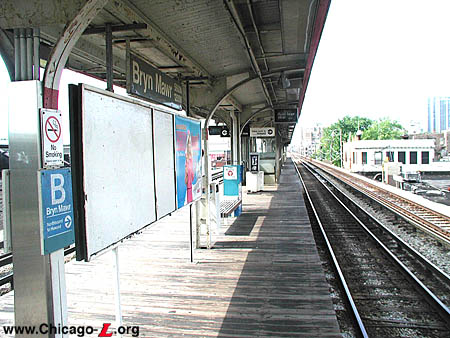
The platform at Bryn Mawr,
looking north on June 14, 2003. The canopy dates from the
1921 track elevation and the stair enclosure (behind the pay
phone) is from a 1974 renovation. The Bryn Mawr station name
sign was installed circa 1998 and is of the new
Current
Graphic Standard
(though the colored tabs on either side have been omitted to
fir the existing bracket). For a larger view, click
here.
(Photo by Graham
Garfield)
|
Bryn Mawr
(5600N/1200W)
Bryn Mawr Avenue and
Broadway, Edgewater
Service
Notes:

|
Red Line:
Howard
|

|
Owl
Service
|
Quick Facts:
Address: 1119 W. Bryn Mawr
Avenue
Established: May 16, 1908
Original Line: Northwestern Elevated Railroad
Previous Names: Edgewater
|
Skip-Stop Type:
|

|
Station
|
Rebuilt: 1921, 1974
Status: In Use
History:
"L" service first entered north Chicago and Evanston by way of an
agreement to use the tracks of the Chicago, Milwaukee and St. Paul
Railway's tracks, replacing the steam service that
the St. Paul had previously provided. The Chicago City Council
authorized the electrification of the tracks of the Chicago,
Milwaukee and St. Paul Railroad's tracks from Graceland Avenue
(Irving Park Road) to the city limits on July 1, 1907. Unlike Evanston (as per the 1907 franchise agreement from the city),
the Chicago City Council did not require that the grade-level tracks
be elevated, but they did prohibit the use of a third rail for
safety's sake, necessitating the use of overhead trolley wire. "L" service north of Wilson to Central Avenue in Evanston began on May 16, 1908.
The St. Paul had a station named Edgewater at Bryn Mawr Avenue near Evanston Avenue (now Broadway). The station, of a style typical of railroad depots, was located on the east side of the tracks on the south side of Bryn Mawr. As they did at the other stations on the newly electrified line, the Northwestern Elevated Railroad chose not to use the station facilities of the St. Paul steam railroad, which were situated and designed for the needs of a main line commuter railroad rather than a rapid transit service. Instead, the Northwestern built a new station at the same location as the St. Paul's station. The "L" station facility at Edgewater was a
simple ground-level station and modest platform on the south side of Bryn Mawr Avenue. The station house was
a small, wood frame building set between the two tracks at ground
level with a wooden walkway and stairs leading up to it from the street. The
exterior used clapboard siding and a hipped roof with eaves. The rear
opened out onto an island platform. The platform had a short canopy with a hipped roof (which was actually a continuation of the station house's roof) and center wooden columns with angled brackets, and wood decking.
Track Elevation and a New Station
In the mid-1910s, the Northwestern Elevated began to elevate the
tracks north from Wilson to Howard, but
work was slow due to the city's refusal to close intersecting streets
and the narrow right-of-way. The elevation work involved complex staging and the temporary relocation of tracks to maintain service while building the new elevated embankment in the same right-of-way. In early 1916, trains were moved onto a
temporary trestle, allowing demolition of the original tracks and stations, but construction of a permanent embankment had to
wait until the end of World War I due to a materials shortage.
With the track elevation came a completely new station. The entrance to the "L" station was located on the south
side of Bryn Mawr Avenue. The station had a design typical of the
facilities built as part of the Wilson-Howard elevation project.
Designed by architect Charles P. Rawson and engineered by C.F Loweth,
the architectural design was a Prairie School-influenced vernacular
form, with the Prairie influence seen most acutely in the ornamental
cement pilasters on the front facade and in the details of the wooden
doors, windows, and ticket agents' booths. The exterior was brick and
cast concrete with a bedford stone base, wooden doors and large plate
glass windows and transoms. Ornamental globed light fixtures
decorated the pilaster capitals. The station house was centered
within the solid-fill embankment, with retail spaces flanking it on
both sides filling in the remaining width of the embankment.
The interior was rendered in plaster, wood, glazed brick, and
brick with terrazzo floors. There were arches stretching across the
interior between the support columns. In the center of the interior,
passengers found a decorative wooden ticket agent's booth with
ornamental woodwork and a metal grille over the ticket agent's
window. The station also had public restrooms.
There were four tracks through Edgewater station, but the outer two tracks were for express trains and were not served by the station. A single island platform between the two center tracks served local trains. The platform
had wood decking and a canopy with metal columns down the center line
which split into gently-curving gull wing-shaped roof supports,
supporting a wooden canopy roof. The stairs were sheltered by wooden
enclosures with wooden bottoms and windows on top, divided into rows
of square panes, with swinging doors at the front of each enclosure. Like most of the stations north
of Lawrence, there was an
auxiliary exit, located on the north side of the street, descending down in
the middle of retail spaces built under the elevated. Bryn Mawr is one of the only stations between Wilson to Howard to retain this auxiliary exit in service today.
In December 1920, it was reported that the Bryn Mawr station, along with Argyle, Edgewater Beach,, Thorndale, Granville, and Jarvis, would be completed by late Spring 1921.1 By
early 1922, the new four track mainline was completed, allowing full
express service to the city limits.
By 1926, the station's name had been changed to Bryn Mawr.
Station Renovation
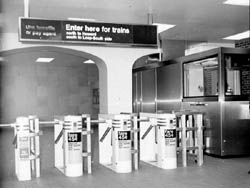
The renovated Bryn Mawr
station house, seen here shortly after completion in 1974,
had all new flooring, wall treatments, fare controls,
agent's booth, and signage. For a larger view, click here. (Photo from
CTA Collection) |
Bryn Mawr station was rehabilitated in 1974, in a project that
kept most of the station's existing superstructure and a good deal of
the existing finished build-out, at least at the platform level. The
rehab included a complete reworking of the station house, including a
new front facade (some of the pilasters were left in place, but it
received otherwise all-new facing, windows and doors), new fare
controls and agent's booth, new concession, new flooring, and new
wall and ceiling finishes. The basic form of the original station
house remained visible, most readily identifiable in those arched
columns, but otherwise it was an entirely new interior. The
electrical and mechanical systems were upgraded as needed. One set of
stairs to the station house and the auxiliary exit stairs were
upgraded with new materials, but another of the stairs to the station
house was replaced with an all-new escalator. All three vertical
access paths received new lighting.
At platform level, more was left intact. The original 1920s canopy
remained, although it was cleaned, repaired, and repainted. The
wooden platform deck, while repaired and replaced as needed, remained
in the same materials. New stainless steel, aluminum and Plexiglas
enclosures were built around the stairs and escalator down to
street-level, replacing the original wooden kiosks that had been
there previously. All new lighting was installed under the canopy, as
well as on the platform beyond the canopy. New signage was installed
throughout the station. Currently, Bryn Mawr is the only station
built in the 1920s North Side elevation project to still have its
auxiliary exit stairway across from the main station entrance open and in use (Morse still has a secondary exit as well, but to another street).
Recent Developments
In 2006, the station name signs and column signs on the platform
were replaced, with Green Line
Graphic Standard signs replacing the KDR
Standard graphics, and new entrance signs installed as part of a
signage upgrade project on the Red Line. As part of this effort, the
station also received granite compass roses inset into the sidewalk
in front of the station entrance to assist customers leaving the
station to navigate their way, and three-sided galvanized steel
pylons in the station house and on the platform to display maps and
station timetables.
In 2008, the canopy at Bryn Mawr was refurbished. The roof was
removed and replaced with a new corrugated metal top. The metal
canopy supports were stripped and repainted. New lighting was also
installed as part of the renovation.
Upcoming Renovation
On Tuesday, December 18, 2012, the CTA board approved authorizing an agreement with the City to use local funding to help pay for enhancements at Bryn Mawr station, which include a station house renovation and the addition of an elevator to make the station accessible. The CTA has identified $25 million in funds for improving the station. State and federal funds provide $15 million of funding, while $10 million comes from tax increment financing. Details of what specific work will occur at the station and a timeline for when work will begin have not yet been determined, according to the CTA.2 Mayor Rahm Emanuel introduced a proposal to City Council on February 13, 2013 to support the enhancements to the Bryn Mawr station with up to $10 million in Tax Increment Financing (TIF) assistance.3
The project is planned to include new lighting, fixtures, and platform surfaces, along with upgrades to the existing station house, tracks, and elevator.4
Bryn Mawr was not part of the Red North Station Interim Improvements Project, which improved seven North Side Red Line stations in 2012 -- Jarvis, Morse, Granville, Thorndale, Berwyn, Argyle and Lawrence -- which included renovations to the station facilities and the viaducts and tracks through the station areas. That work included substantial improvements to the stations, including masonry work, new interior flooring and finishes, new platform decks, and new lighting and signage, but did not include the addition of elevators for accessibility. It is not clear if the work being planned for Bryn Mawr will be life-extension work like that in Red North Station Interim Improvements Project until the Red-Purple Modernization Project (RPM) (see below) can rebuild the station, or if the project will perform the complete reconstruction envisioned in the RPM Project.
Red-Purple Lines Modernization (RPM) Project
Due to the deteriorating condition of the infrastructure on the Red Line north of Belmont and on the Purple Line, the CTA initiated the Red-Purple Modernization Project (RPM) to bring the existing transit stations, track systems, and structures into a state of good repair. The project, which stretches along the existing Red and Purple lines from north of Belmont station to Linden terminal, would help bring the existing transit line into a state of good repair, reduce travel times, improve access to job markets and destinations, and provide improved access to people with disabilities.
The project began in 2009 with a vision study to assess the scope of needs and develop a set of alternatives for study. In 2010, in accordance with the National Environmental Policy Act (NEPA), CTA and Federal Transit Administration (FTA) initiated the environmental review process for the project and undertook work to develop an Environmental Impact Statement (EIS). The process included numerous public meetings and input opportunities, and study of various alternatives for achieving a good state of repair for the infrastructure in the project area.
A number of alternatives are under consideration for the RPM project, including the comprehensive reconstruction of track, stations, and structures along the line. The four options currently under consideration and study, not including an FTA-required "no action" baseline scenario, include:
- Basic Rehabilitation: provides a strategic mix of repairs, rehabilitation, and replacement of the existing infrastructure for a useful life of 20 years, plus the addition of a transfer station at Loyola; all station locations remain the same.
- Modernization with Station Consolidation: provides a brand new elevated structure between Lawrence and Howard, modern amenities at stations, increases speed of service, includes new transfer station at Loyola, and major reconstruction and renovation to extend the useful life to 60-80 years; several stations would be consolidated by closing one station and adding a second entrance at an adjacent station.
- Modernization without Station Consolidation: provides a brand new elevated structure between Lawrence and Howard, modern amenities at stations, modest increase in speed of service, includes new transfer station at Loyola, and major reconstruction and renovation to extend the useful life to 60-80 years; all station locations remain the same.
The Modernization with Station Consolidation option includes the consolidation of Thorndale station with the Granville and Bryn Mawr stations by closing the existing Thorndale station and adding entrances to Granville and Bryn Mawr -- at Glenlake Avenue for Granville station, approximately one block north of Thorndale station and one block south of Granville station.; and at Hollywood Avenue, approximately two blocks south of Thorndale station and one block north of Bryn Mawr station.
Other alternatives considered earlier in the study but subsequently eliminated due to public comment and further study included basic rehabilitation without adding a transfer station at Loyola, a modernization option with only three tracks between Lawrence and Howard, and a modernization option with a 2-track subway under Broadway.
The full-scale modernization envisioned on the Red-Purple Modernization Project could cost anywhere from $2.5 to $5 billion. On February 8, 2012, the CTA board retained Goldman Sachs & Co. to lead the search for public-private partnerships to help finance the reconstruction, which has no firm date. Goldman Sachs will work with Chicago-based Loop Capital Markets LLC and Estrada Hinojosa & Co., but will accept no fee for the first year as it determines the ability to raise private capital.
See CTA's Red & Purple Modernization page for more information about the scoping and planning process, and the various alternatives being considered.
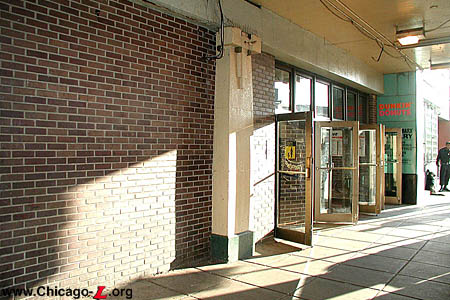
Bryn Mawr's exterior got a
new facade in the 1974 renovation. The Prairie School
columns were retained, but otherwise the exterior was clad
on nondescript brick facing with glass and stainless steel
windows and doors, seen looking southwest on June 14, 2003.
For a larger view, click here.
(Photo by Graham
Garfield)
|

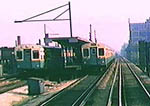
|
brynmawr01.jpg
(31k)
The Bryn Mawr station circa 1960 looking north from the
northbound express track. Two 6000-series
trains wait at the platform, the one on the right
northbound, the left southbound. This photograph was taken
from a moving northbound North Shore Line train.
(Photo from North Shore Line, from
Sunday River Productions)
|
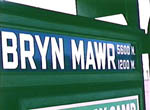
|
brynmawrSign.jpg (35k)
An original blue and white enamel Bryn Mawr platform sign.
These remained at the station until its renovation in the
mid-1970s. (Photo from North Shore
Line, from Sunday River Productions) |
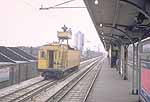
|
ctaS-330b.jpg (104k)
Line car S-330, seen passing Bryn Mawr station on October 4,
1972, was created from Northwestern wood car 1755 in April
1956. The car body was built from 1755 and salvaged
materials from the Skokie carpenter's shop and the lift platform, which is raised by a
hoist, was salvages from a CSL truck. (Photo
by Steve Zabel, Collection of Joe Testagrose) |
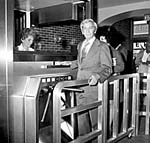
|
brynmawr07.jpg (84k)
A man poses at the new agent's booth, controlled by a
Visifare turnstile, at the reopening celebration festivities
following extensive renovation at Bryn Mawr station on May
12, 1974. (CTA Photo) |
|
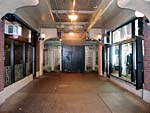
|
brynmawr05.jpg
(180k)
Across from the main entrance, a corridor leads back from
the sidewalk on the north side of Bryn Mawr Avenue to an
auxiliary exit from the platform, controlled by two
rotogates. Seen looking north June 14, 2003, this side was
not modified in the 1974 station rehab, showing what the
original exteriors looked like, including the light
fixtures. (Photo by Graham
Garfield)
|
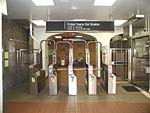
|
brynmawr06.jpg
(152k)
The interior of the Bryn Mawr station house is still largely
as it was outfitted in the 1974 renovation, with the
exception of modern Cubic farecard turnstiles, seen looking
south at the fare controls from the unpaid area on June 14,
2003. (Photo by Graham Garfield)
|

|

|
Notes:
1. "3 NEW STATIONS ON NORTH SIDE "L" READY JAN. 1." Chicago Daily Tribune, 1920 December 1, pg. 21.
2. Swartz, Tracy. "Bryn Mawr stop to see overhaul." Red Eye, 2012 December 19.
3. "TIF Proposed For Bryn Mawr Red Line Station Improvements". City of Chicago press release, 2013 February 13.
4. Ibid.











